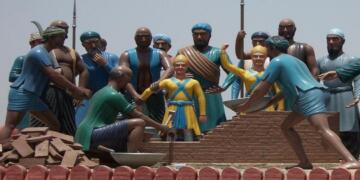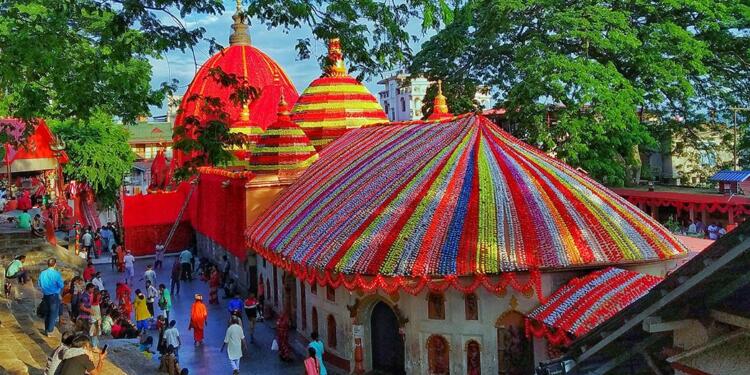High atop the Nilachal Hill in Assam, veiled in mist and myth, lies one of the most enigmatic temples in India- Kamakhya Devi Temple. It’s a place where belief defies convention, where the divine feminine is worshipped not through towering idols, but through the most intimate and primal symbol of life: the womb.
Each year, as the monsoon clouds gather over the Brahmaputra Valley, something extraordinary happens. The temple shuts its gates. The rituals stop. The goddess, they say, is menstruating.
Here, menstruation is not taboo. It is sacred.
A Temple Unlike Any Other
Kamakhya Devi Temple isn’t just a place of prayer; it’s a portal into a different worldview. One that reveres the Shakti (feminine energy) not in abstraction, but in its raw, biological truth.
There is no idol of the goddess in the sanctum. Instead, devotees bow before a yoni-shaped stone symbolizing the womb kept moist by an underground spring. It is believed to mark the exact spot where Sati’s yoni (genitalia/womb) fell after her body was dismembered by Vishnu’s Sudarshan Chakra to stop Lord Shiva’s grief-driven rampage.
This is not metaphor. This is Kamakhya: where the myth becomes matter, and the matter becomes sacred.
A Legend Born in Fire and Grief
To understand Kamakhya, we must journey into one of Hinduism’s most potent myths.
Sati, daughter of the proud king Daksha, was Shiva’s consort and the first embodiment of Shakti. When Daksha insulted Shiva; Sati, unable to bear the dishonor, self-immolated in protest. Consumed by grief, Shiva carried her charred body across the cosmos, his sorrow threatening to unravel the universe itself.
To save creation, Vishnu used his divine weapon to sever Sati’s body, and as her parts fell to earth, they became the 51 Shakti Peethas- sacred sites that pulse with feminine energy. Among them, Kamakhya is considered the most intimate. It is where life begins.
But Kamakhya is not a shrine only of loss and grief. Local lore also holds that this hill was the place where Kamadeva, the god of desire, was reborn; restored after being burnt by Shiva’s fiery gaze. This too, adds to the temple’s layered symbolism: creation, desire, regeneration.
Ambubachi: When the Goddess Rests
Once a year, usually in June, Kamakhya marks a sacred event known as Ambubachi Mela. For three days, the temple doors are closed. No rituals are performed. No idols are touched. Even the land is left untouched- plowing and sowing come to a halt.
The reason? It is believed that during this time, the goddess is menstruating.
It is a radical reversal of dominant narratives that surround menstruation; often cloaked in shame, seen as impure, or silenced. In Kamakhya, the goddess bleeds. And the world waits in reverence.
Inside the sanctum, the waters of the spring near the yoni stone are said to turn red during this period. Whether through natural minerals or divine mystery, no one truly knows. But thousands believe. For them, this is not superstition, it is Shakti’s presence made manifest.
A Festival of Rebirth
On the fourth day, Kamakhya reawakens. The gates open. The silence breaks. And the temple erupts in ritual and celebration.
Special prasad is distributed: a red cloth, known as Rakta Bastra, believed to have absorbed the goddess’s sacred energy. Devotees carry it home for fertility, protection, and spiritual empowerment.
Perhaps most fascinating of all are the Tantrics- spiritual practitioners who embrace the esoteric path of Tantra. For most of the year, many remain in seclusion, invisible to the world. But during Ambubachi, they gather in Kamakhya. Here, Tantra is not a taboo word, nor is it merely sensual, it is sacred science. It is the merging of opposites: the material and spiritual, the body and the cosmos, the male and the female.
Kamakhya is one of the few remaining temples in India where Tantric worship thrives. It honors the feminine not as passive or modest, but as wild, powerful, cyclical, and divine.
A Temple That Defies Norms
In a world where menstruation is often hidden, where divinity is imagined as male or celibate, Kamakhya offers an alternative vision. One where the womb is worshipped, where bleeding is divine, and where rest is sacred.
The goddess here does not sit on a jeweled throne. She resides in a dark, moist cave, where water flows and life begins. Her power is not in detachment, but in connection to the earth, to the body, to rhythm.
Kamakhya asks its visitors to unlearn. To question what they’ve been taught about purity, piety, and womanhood. It invites them into a space where the feminine is not less than, but everything.
The Mystery Lives On
Kamakhya is not just a temple. It is a mystery, a meditation, and a mirror. One must arrive not just with devotion, but with curiosity. Because here, the goddess doesn’t reveal herself easily. She is hidden, just like the cave in which she resides. Those who seek her must be willing to go inward, the cave and themselves.
Every whisper of the wind on Nilachal Hill carries a story. Every stone sings of creation and destruction, of longing and renewal. And every drop of the sacred spring reminds us of one eternal truth:
Shakti is not an idea. She is a force. She is the body. She is the blood.
So the next time you hear someone whisper about menstruation in hushed tones, cloaked in taboo; remember Kamakhya. Remember there is a place on this Earth where the goddess bleeds, and the world bows in reverence.
This is not just a story.
This is not just a temple.
This is Kamakhya.

































